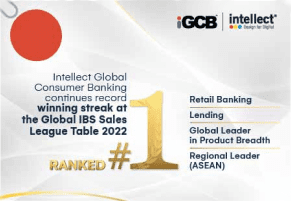With 329 microservices, 1,757 APIs and 535 events, Intellect Design Arena’s eMACH.ai open finance platform is transforming the way banks operate. Its Global Consumer Banking unit (iGCB) has transformed leading banks across the globe for the last 30 years. Rajesh Saxena, CEO of iGCB, retail banking division of Intellect Design Arena, describes the five key trends he sees driving technology change at the very heart of banks – and how they can devise a successful strategy to embrace it

THE FINTECH MAGAZINE: What are the main drivers of change when it comes to core banking technology?
RAJESH SAXENA: Over the last 365 days, I have spent significant time in understanding client needs and ambitions across our key markets.I have probably met more than 100 senior bankers. I have concluded that while each country and customer is different, there are certain common trends and common pain points
The first trend gaining momentum is the rise of Open Banking and Open Finance. The wave started with the UK & Europe and is now being required by most markets. The Middle East has also seen increased traction over the last couple of years
The integration of an Open Finance enabled ecosystem in a bank can offer contextual and curated solutions and experiences for the end customer. In fact we at iGCB have clients like Cater Allen in UK and OTTO in Germany who are leveraging Open Finance to deliver superior banking to their customers. We have similarly implemented Open Finance enabled banking solutions in APAC, Middle East, Africa, and Oceania region.
The second trend is the increased competition from Fintechs and other banks. Banks are looking at options disrupt the status quo, and increase their addressable market by transitioning from a product provider to a marketplace where customers can find a product or service catering to all facets of their lifestyle.
The third key trend, which iGCB has been advising banks for the last few years is the use of cloud, either private or even, in some cases, public cloud. Cloud technology has matured over the last 5-6 years and regulators and large Banks are gaining confidence about its security aspects.
A couple of years back, when we were doing a core banking transformation for a UK private bank, we could not take them to a public cloud because the regulator was not ready. Today, the same customer is planning to migrate to an AWS cloud with us being the core technology partner. I am also happy to share that we’ve just upgraded India’s central bank Reserve Bank of India, which is one of our premier clients, to next-generation core banking and we have taken them to a private cloud on VMware.
The fourth trend, mostly seen in developed markets, is the focus on ESG. The banks’ customers are looking to be net zero, with the ability to greenify/reduce the carbon footprint created by their transactions. Once a niche product feature, now, it’s a fundamental requirement. A report by Alvarez & Marsal stated that the global annual revenue pool for banks related to environmental, social and governance products and services will reach €295 billion, or $300 billion, by 2030. So we can see the potential of ESG on a bank’s profitability.
The fifth and final trend is an increasing amount of regulations around privacy and security that banks have to cope with. The recent one is the EU AI act. These constantly evolving regulations too are motivating banks to consider transforming themselves to a more agile bank.
TFM: So banks globally are under tremendous pressure to transform. However, Banking transformations are never easy. Can you talk us through a successful transformation and what, in your view, needs to be in place for that to happen?
RS: For years, banks were very reluctant to change their core. What most of them opted to do instead was to hollow it out and put systems in place around it that could take care of part requirements.
But banks have now realised that, as a strategy, hollowing the core can only give you a limited benefit. It could still be phase one of your strategy, but if you really want to transform your bank and compete with the new-age digital banks, you need to have a comprehensive core with an ability to evolve.
Also what we are seeing now is that banks are adopting multi-core strategies. Take RBI as an example. We built a bridge between RBI’s old core and a new core, so the bank could use either one or the other, depending on the requirements and what had been implemented. This coexistence capability is gaining traction amongst banks for core transformations.
Apart from the product and technology, I would also emphasise the importance of delivery strategy. It might sound obvious but most delays in implementations occur due to a gap in understanding between the bank and the technology provider. As a partner in the Bank’s transformation journey , we not only create a thorough plan but do detailed design thinking sessions with each client to create an implementation plan which focuses on the stated and unstated needs of the bank and prioritises business impact. As a new initiative, we are further building regional delivery teams to work with banks more closely.
Strategies like these are further reducing the risk of large transformation.
TFM: So how does one create a powerful core? Are there some architectural tenets a CIO should consider?
RS: I strongly suggest that banks invest in a comprehensive core which consists of events, Microservices, APIs, Cloud, Headless architecture and embedded AI use cases. Intellect is the first to bring all these elements together. We at Intellect call it eMACH.ai.
We moved all our architecture into eMACH.ai so that the APIs, microservices, events, are all open. It’s completely born on the cloud and that gives banks the ability to integrate, to scale up, and to connect with ecosystem players. We have also created a country-ready ecosystem for several countries, reducing go-to-market for banks.
Most of our peers are now in the process of moving from a monolithic architecture to this kind of advanced infrastructure. Our investment in eMACH.ai brings considerable advantages to us and puts us ahead of the curve.
But, it’s not just to do with the architecture. Intellect’s sweet spot as a company is between domain and technology. Intellect’s talent comes with deep banking expertise, and that really helps, because just giving banks a tech framework, which is what some of our competitors do, is not enough. We have depth and breadth in the financial services space. From lending to origination, savings accounts to current accounts, we are able to offer a comprehensive platform, built on the same architecture. Also, we co-create and co-innovate with the banks. And that also helps in the transformation journey. We have seen significant success with co-create and co-innovate model with our clients in Africa.
TFM: You say that one of the things that sets you apart and one of the reasons you’ve been successful in terms of some of the transformations you’ve implemented in various banks is the fact that you only work in this domain. Can you give an example of how that helps?
RS: Having come from banking, I know financial services is not a simple domain, it requires deep understanding. Companies that are horizontal in nature will not be able to bring the vertical depth of knowledge that is required for it.
I’ll give you an example to do with AI. Today, AI is at the forefront of every conversation, including in the banking space. When we talk to people about AI most of them, because they use Microsoft Windows, will have an Azure Copilot bundled along with it. But having a horizontal AI play like that is not enough. What you really need to know is how to use AI to create, for example, an underwriting use case or a wealth use case or a corporate use case. Our credit-focused Gen AI solution has created waves in the market with its capabilities in underwriting.
Those vertical domain use cases are the key and that’s why I’m of the firm belief that companies like ours, with a sole focus on the banking domain and 30 years of experience transforming Tier 1 banks across the globe, add significant value.
TFM: Intellect Global Consumer Banking is a sponsor for Money20/20 Europe this year. Can you tell us more about the products you’ll be focussing on there?
RS: Money20/20 is a flagship event for iGCB. This year, we’ll be focussing on three things specifically.
One is our Digital Engagement Platform, which is a single, common platform for the retail customer, the SME customer, and the corporate customer. If you are a Tier 2 or a Tier 3 bank with a strong retail business, and a moderate-sized commercial business, you do not need two portals for them, because two portals come with huge expenses and involve a huge amount of work. So we have created one common, no-code platform for both.
The advantage of no-code is that the bank itself can make changes on the digital layer – because time to market is very important. We believe that the Digital Engagement Platform could be a game changer for banks across the globe including European banks still using legacy digital banking.
At Money20/20 we will also showcase how we can help banks implement dual-core strategy, our Gen AI platform built for banks and our digital lending suite, iKredit 360.
TFM: So, finally, what would your advice be for banks that want to implement a successful transformation?
RS: I can’t emphasise enough on the importance of choosing a platform that is open finance enabled and completely cloud native. A platform is going to be with you for the next eight to 15 years, depending on your appetite, right? So you definitely need to choose one that has the latest architecture and which is completely cloud-native – not just ‘cloud ready’ or ‘cloud-enabled’.
The second thing I’d say is that transformation is a long journey and you need to be able to work well with a vendor to deliver it. So the cultural fit of your organisation with the vendor is very important. It can make or break the project.
Finally, in my view, transformation has to be driven from the top. Sometimes we’ve seen it being driven by the technology group in a bank. Sometimes it’s being driven by the business group. And sometimes there is a friction between these two. But it has to be both a business and a technology agenda. All the parties have to be joined at the hip for this. You can have a great product, but if the culture piece, the team piece, the agile working, and the buy-in from both the business and technology groups aren’t there, it won’t be the success that it could be.
Source: https://ffnews.com/?p=283164&preview=1&_ppp=7d94cebd50







